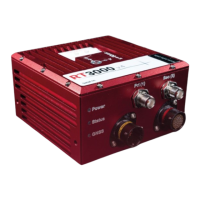Oxford Technical Solutions Ltd Page 10 of 110
Introduction
Thank you for choosing the RT3000 v4 inertial navigation system. The RT3000 v4 combines dual GNSS
receivers and a high-grade multi-core MEMS IMU into one self-contained package for making precision
measurements of position and motion in real time.
Important information is highlighted throughout this manual in these boxes.
The RT family consists of the RT500 v1, RT1003 v2, RT3000 v3 and RT3000 v4. (N.B. The RT3000 v4 has a
variant supporting Terrastar™ called the RT3000 T v4. Except when explicitly mentioned, when this manual
refers to the RT3000 v4, it refers to both the R3000 v4 and RT3000 T v4).
Each member of the RT family of products has different performance options. The RT3000 v4 and RT3000 T
v4 products are covered in this manual. The RT1003 v2, RT500 v1 and RT3000 v3 products have their own
manuals, which can be downloaded from the OxTS Support website - https://support.oxts.com/.
As with the RT3000 v3, the RT3000 v4 is capable of running the OxTS RT-Range Processing engine for vehicle-
to-vehicle and vehicle-to-lane testing inside the RT itself. This functionality used to be available from the RT-
Range S Hunter accessory but now runs on board the RT3000 v3 and RT3000 v4 as an optional feature. If you
are configuring an RT-Range S Hunter for ADAS testing then you will need to refer to the RT-Range user manual
– available to download at https://support.oxts.com/.
To obtain high-precision measurements, the RT uses mathematical algorithms developed for use in fighter
aircraft navigation systems. An inertial sensor block with accelerometers and gyroscopes in three axes is used
to compute all the outputs. A WGS 84 modelled strapdown navigator algorithm compensates for earth
curvature, rotation and Coriolis accelerations, while measurements from high-grade kinematic GNSS receivers
update the position and velocity navigated by the inertial sensors. This innovative approach gives the RT several
distinct advantages over systems that only use GNSS:
The RT has a high (100 Hz, 200 Hz or 250 Hz) update rate and a wide bandwidth.
The outputs are available with low, 1 ms latency.
All outputs remain available continuously during GNSS blackouts when, for example, the vehicle drives
under a bridge.
The RT recognises jumps in GNSS position and ignores them.
The position and velocity measurements the GNSS makes are smoothed to reduce the high-frequency
noise.
The RT makes many measurements GNSS cannot, for example acceleration, angular rate, pitch and roll.
An RT system processes data in real time. The real-time results are output via an RS232 serial port, over 10/100
Base-T Ethernet using a UDP broadcast and on CAN bus. Outputs are time-stamped and refer to GPS time; a
1PPS timing sync can be used to give accurate timing synchronisation between systems. The inertial
measurements are synchronised to the GPS clock.

